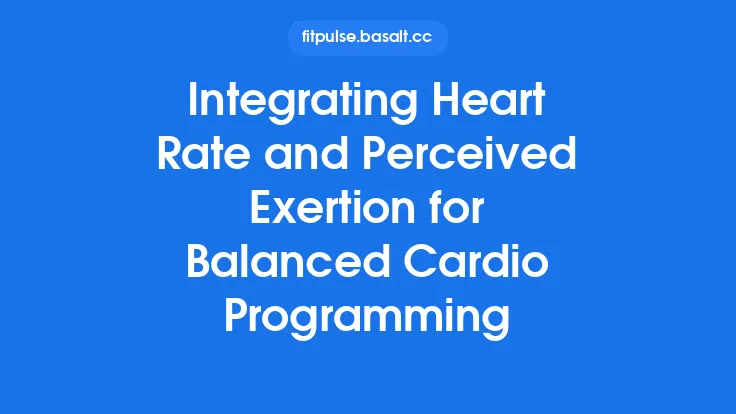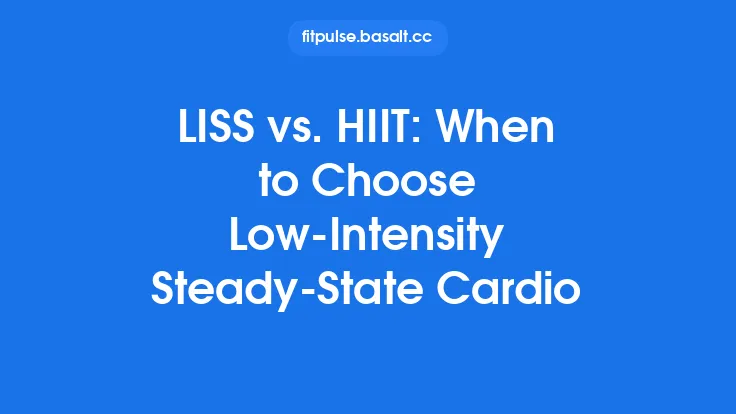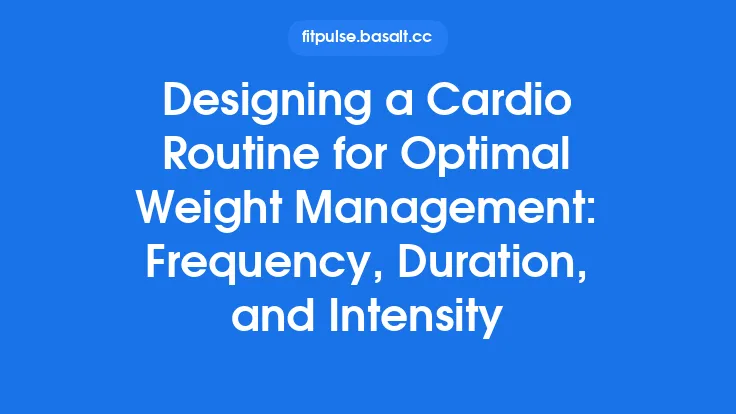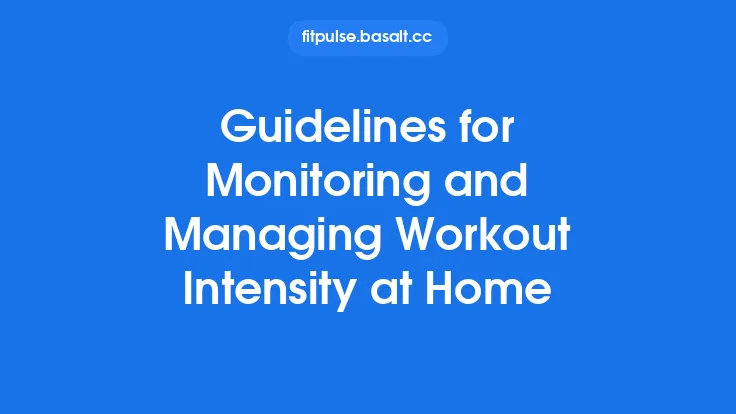Low‑intensity steady‑state (LISS) cardio is defined by a prolonged, moderate workload that can be sustained for 30 minutes or more without causing a rapid rise in fatigue. Because the absolute intensity is modest, the primary challenge for practitioners is not “how hard should I push?” but rather “how can I be sure I’m staying in the intended effort zone?” Objective tools such as heart‑rate monitors are useful, yet many athletes and recreational exercisers rely on simple, cost‑free methods that tap into the body’s own feedback systems. Two of the most widely adopted subjective techniques are the Talk Test and the Rating of Perceived Exertion (RPE). When used correctly, they provide reliable, real‑time insight into cardiovascular strain, allowing the practitioner to fine‑tune the session on the fly, maintain consistency across workouts, and avoid inadvertent drift into higher‑intensity zones.
Understanding the Talk Test
Historical context and practical appeal
The Talk Test originated in clinical exercise testing as a quick, bedside method to gauge ventilatory threshold. Its premise is straightforward: during a steady‑state effort, an individual should be able to speak in full sentences without gasping for air. If speech becomes fragmented or impossible, the intensity has likely exceeded the LISS range.
Physiological underpinnings
When exercising at low to moderate intensity, the body meets its oxygen demand primarily through aerobic metabolism. Ventilation (minute ventilation, VE) rises proportionally with oxygen uptake (VO₂) but remains well below the point where lactate accumulation forces a disproportionate increase in breathing. The ability to converse reflects that VE is still comfortably matched to metabolic needs. Once the ventilatory threshold is crossed, the respiratory system must work harder to clear excess CO₂, and speech becomes labored.
Operationalizing the test
- Baseline conversation – Before starting, have the exerciser recite a familiar sentence (e.g., “The quick brown fox jumps over the lazy dog”) at a normal speaking pace.
- During exercise – Every 5–10 minutes, ask the exerciser to repeat the sentence.
- Interpretation
- Easy talk – Full sentences spoken comfortably → intensity is within the lower LISS band (≈ 40–50 % VO₂max).
- Moderate talk – Sentences are spoken, but with slight breath pauses → still acceptable for LISS (≈ 50–60 % VO₂max).
- Hard talk – Only short phrases or single words can be uttered → intensity has likely entered the high‑moderate zone, beyond typical LISS.
Advantages and limitations
The Talk Test requires no equipment, is intuitive, and can be applied across modalities (treadmill, bike, elliptical). However, it is influenced by individual speech patterns, language proficiency, and environmental noise. It also provides a coarse granularity; two exercisers may both be in the “moderate talk” zone but be operating at different absolute workloads.
The Perceived Exertion Scale: RPE Explained
From Borg to modern adaptations
The original Borg Scale (6–20) was designed to correlate numerically with heart rate (HR ≈ RPE × 10). Later, the 0–10 Category Ratio (CR‑10) scale emerged, offering a more intuitive, “pain‑like” rating. Both scales capture the integrated sensation of effort, breathlessness, muscle fatigue, and cardiovascular strain.
How RPE is generated
Perceived exertion is a central construct that synthesizes afferent signals from:
- Mechanoreceptors in muscles and joints (detecting force and stretch).
- Metaboreceptors sensing chemical changes (e.g., lactate, pH).
- Chemoreceptors in the carotid bodies responding to blood O₂/CO₂ levels.
- Cardiovascular baroreceptors reflecting changes in blood pressure and heart rate.
The brain integrates these inputs, producing a subjective rating that, when calibrated, aligns closely with physiological markers.
Applying RPE to LISS
For low‑intensity work, the target RPE typically falls between 2–3 on the 0–10 scale (or 9–11 on the 6–20 scale). This corresponds to “very light” to “light” effort, where the exerciser can maintain the activity for an extended period without feeling strained.
Guidelines for consistent use
- Pre‑session familiarization – Explain the scale, have the exerciser rate a known activity (e.g., walking at a leisurely pace) to anchor the numbers.
- Periodic checks – Prompt the exerciser to report RPE every 5–10 minutes.
- Adjustment protocol – If RPE rises above 4, reduce speed or resistance; if it falls below 2, increase slightly to stay within the intended zone.
Strengths and caveats
RPE is highly adaptable, works across all exercise modalities, and can be recorded easily in a training log. Its subjectivity, however, can be affected by mood, fatigue from prior sessions, or external stressors, necessitating occasional cross‑validation with objective metrics.
Physiological Basis for Effort Perception
While the Talk Test and RPE are often treated as “black‑box” tools, understanding the underlying physiology clarifies why they are reliable for LISS monitoring.
| Physiological Signal | Primary Contributor to Talk Test | Primary Contributor to RPE |
|---|---|---|
| Ventilation (VE) | Directly limits speech cadence; higher VE → fragmented speech | Contributes to breathlessness component of RPE |
| Heart Rate (HR) | Correlates with VE; HR > 120 bpm often coincides with “hard talk” | HR elevation sensed via baroreceptors, influencing overall effort rating |
| Blood Lactate | Low at LISS; lactate accumulation leads to rapid breathing, affecting talkability | Rising lactate adds a “burn” sensation, raising RPE |
| Muscle Metaboreceptors | Minimal activation at low workloads | Detect subtle fatigue, feeding into RPE |
| Thermoregulatory Load | Mild sweating does not impede speech | Heat perception adds to perceived effort |
Because LISS operates below the lactate threshold, the dominant signals are ventilatory and cardiovascular, both of which are readily perceived through speech capacity and overall effort rating.
Integrating Talk Test and RPE in LISS Sessions
Using both tools together creates a redundancy that improves accuracy.
- Initial calibration – Begin the session at a speed/resistance that yields a “moderate talk” and an RPE of 2–3. Record these baseline values.
- Mid‑session cross‑check – At the 15‑minute mark, ask the exerciser to repeat the sentence and report RPE. If both indicators remain within target ranges, continue unchanged.
- Conflict resolution –
- Talk Test indicates easy, RPE indicates higher → Consider psychological factors (stress, fatigue) and possibly reduce intensity.
- Talk Test indicates hard, RPE low → Check for environmental factors (e.g., wind, temperature) that may affect speech without raising overall effort; adjust accordingly.
- End‑of‑session verification – Final talk test and RPE should still be within target; if they have drifted, note the deviation for future session planning.
By documenting both metrics, athletes can track trends (e.g., a gradual shift toward “hard talk” at the same speed) that may signal adaptation or the need for progressive overload—without explicitly entering the overload discussion, this observation remains within the monitoring scope.
Practical Guidelines for Real‑World Application
- Environment – Choose a quiet area for the Talk Test; background noise can mask speech difficulty.
- Consistency of language – Use the same sentence or phrase each time to reduce variability.
- Frequency of checks – For sessions ≤ 30 min, a single mid‑point check suffices; for longer sessions, repeat every 10 min.
- Recording – Log speed/resistance, heart rate (if available), Talk Test outcome (Easy/Moderate/Hard), and RPE. Over weeks, patterns emerge that help fine‑tune training loads.
- Group settings – In class formats, the instructor can cue the entire group to perform the Talk Test simultaneously, fostering a shared perception of effort.
Using Technology to Complement Subjective Measures
While the Talk Test and RPE are low‑tech, modern wearables can provide corroborative data:
- Heart‑rate zones – Set a target HR band that corresponds to ~50 % VO₂max (often 90–110 bpm for many adults). If HR spikes above the band while Talk Test and RPE remain low, investigate external stressors.
- Breathing rate monitors – Some chest straps estimate breaths per minute; a sudden rise may precede a shift in Talk Test status.
- Smartphone apps – Apps that prompt the user to input RPE at preset intervals can automate data collection and generate trend graphs.
Importantly, technology should not replace the subjective checks but serve as a secondary validation layer, especially when environmental conditions (e.g., high altitude) alter the relationship between HR and perceived effort.
Common Misconceptions and Troubleshooting
| Misconception | Reality | How to address |
|---|---|---|
| “If I can sing, I’m definitely in the LISS zone.” | Singing often requires higher ventilatory control; a person may still be near the upper LISS limit. | Use a simple conversational sentence rather than sustained vocalization. |
| “RPE is only useful for high‑intensity work.” | RPE scales are calibrated for the full intensity spectrum; low numbers are meaningful for LISS. | Emphasize the 0–10 scale and anchor low values with familiar activities. |
| “Heart rate alone tells the whole story.” | HR can be elevated by caffeine, stress, or dehydration, independent of exercise intensity. | Cross‑check HR with Talk Test and RPE to confirm true effort. |
| “If my Talk Test is ‘easy’ but RPE is 4, I’m overexerting.” | RPE integrates more than ventilation (e.g., muscular fatigue, temperature). | Consider external factors (heat, prior training) and adjust intensity accordingly. |
Adapting Monitoring for Different Populations
- Older adults – May have reduced speech clarity; use shorter phrases (“Can you say ‘yes’?”) and rely more heavily on RPE, which tends to be reliable when calibrated with familiar daily activities.
- Youth athletes – Encourage playful language (“Can you tell a joke while you run?”) to keep the Talk Test engaging; monitor RPE closely as children may under‑report effort.
- Clinical populations (e.g., cardiac rehab) – Combine Talk Test with a modified Borg scale (0–10) and strict HR limits prescribed by a physician. Documentation is essential for safety audits.
- High‑altitude training – Ventilatory response is amplified; the Talk Test may become “hard” at lower absolute workloads. Adjust target RPE downward (e.g., aim for 1–2) to maintain true LISS intensity.
Sample Monitoring Protocols
Protocol A – Walking on a Treadmill (45 min)
- Warm‑up 5 min at 2.5 mph, RPE ≈ 1.
- Increase to 3.0 mph; perform Talk Test (moderate) and record RPE (2).
- Every 10 min: repeat Talk Test, note RPE. If Talk Test shifts to “hard” or RPE > 3, reduce speed by 0.2 mph.
- Cool‑down 5 min, return to 2.5 mph, RPE ≈ 1.
Protocol B – Stationary Bike (60 min)
- Begin at 50 W; ask exerciser to recite the sentence (easy) and report RPE (2).
- Every 12 min: repeat Talk Test, record RPE.
- If Talk Test becomes “moderate” but RPE stays ≤ 3, maintain power; if RPE climbs to 4, drop power by 5 W.
- End with 5 min at 30 W, RPE ≈ 1.
Both protocols illustrate how the two subjective tools guide minute‑by‑minute adjustments without the need for complex calculations.
Future Directions in Effort Monitoring
Research is increasingly exploring hybrid models that fuse physiological signals with machine‑learning algorithms to predict perceived effort. Wearables that capture respiratory sounds, skin temperature, and motion patterns could automatically generate a “Talk Test index” or an “RPE estimate” in real time. Until such technologies become mainstream, the combination of the classic Talk Test and RPE remains a robust, accessible method for ensuring that LISS sessions stay within the intended effort envelope.
By consistently applying the Talk Test and Rating of Perceived Exertion, practitioners can maintain precise control over low‑intensity steady‑state cardio, promote training fidelity, and gather meaningful data that supports long‑term progression—all without reliance on expensive equipment or complex laboratory testing.





